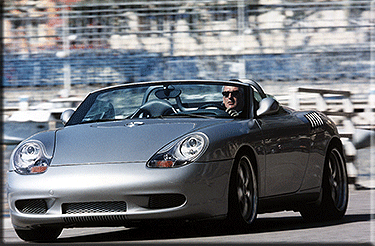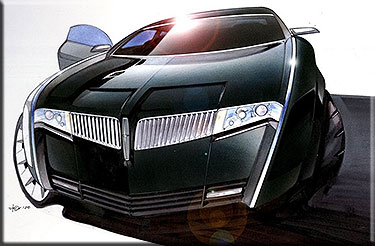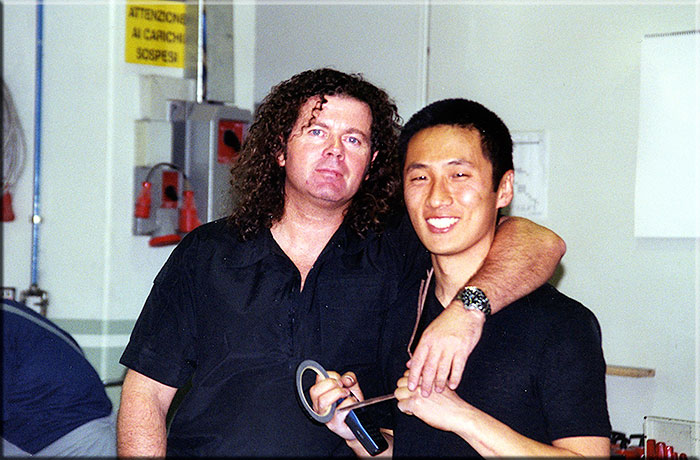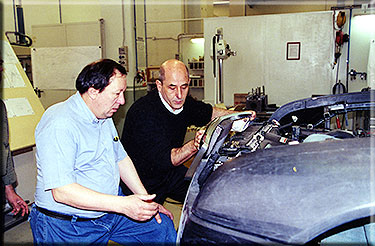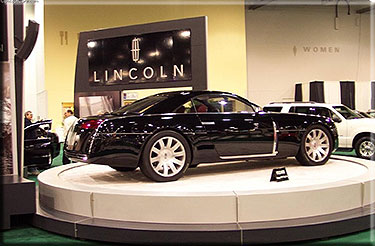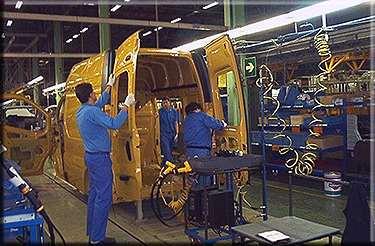SEPTEMBER 2000
At the end of September 2000, Ferrari entrusted STOLA s.p.a with the complete development of the F137 project, which went on to be known as 612 Scaglietti, a tribute to the historic coachbuilder and designer from Modena.
Compared to the previous 456M, the 550, and 575M Maranello, Ferrari commissioned Stola to engineer the chassis, body and its moving parts all in sheet aluminum rather than steel.
This specific technological choice of aluminum was no accident, adding the name Scaglietti to the number 612 immediately brought to mind one Ferrari icon, the GTO, along with the "one off" type 375 MM Coupe of Swedish actress Ingrid Bergman.
Engineer Amedeo Felisa, Technical Director of Ferrari, for this project was very demanding of both his own and Stola’s teams with regards to quality standards, appointing Engineers Maurizio Rossi as manager of styling pre-feasibility and the engineer Maurizio Manfredini as project manager.
The ability to develop the engineering of the F137 in the two VR rooms in the Rivoli and Cinisello Balsamo offices, installed a few months previous, was highly appreciated by the Ferrari management.
The first level of technical management for Stola was, as always: Carlo Biassoni, Gottardo Bustreo, Gianfranco Morlacchi, Alessandro Ghezzi, Giuseppe Castiglioni, Roberto Arpini, La Rosa and Piero De Micheli as project manager, they were joined by Engineer Carlo Alecci in 1997.
The Stola Team Leaders were Paolo Zerbini for body and finishes, Giuseppe Castiglioni for internal finishes, Alessandro Ghezzi, moving parts, Roberto Lauber for structural calculations and Paola Busato for bill of materials.
The styling for F137 was the work of Pininfarina, magnificently inspired by the Pininfarina 375 MM Coupè Speciale from 1954.
 They change December 2000. At the Pininfarina Style Center, Piero De Micheli della Stola and Piero Migliorini of Ferrari evaluate the technical cuts of the style model of the F137During the construction of the exterior and interior style models at the Cambiano Style Center, the Stola technicians, coordinated by De Micheli began the pre-feasibility studies.
They change December 2000. At the Pininfarina Style Center, Piero De Micheli della Stola and Piero Migliorini of Ferrari evaluate the technical cuts of the style model of the F137During the construction of the exterior and interior style models at the Cambiano Style Center, the Stola technicians, coordinated by De Micheli began the pre-feasibility studies.
The first objective to start the actual engineering was is to have the two validated Mathematical Verification Masters.
In the first few days of 2001, the two style models arrived at the Rivoli headquarters, the first activity was to undertake a very accurate optical light scan of the two models, carried out personally by Roberto Planesio, owner of the Vectorin company.
The team of Massimo Stola and Carlo Mantovani created the class A mathematics of the exterior and interior of F137 using the virtual room at Rivoli for the first time.


Rivoli January 2001. The style model of the F137 designed and built by Pininfarina is transported to Stola s.p.a. for the surveys with the aim of realizing class A mathematics.
 Rivoli January 2001. The first phase of the optical survey carried out by Vectorin at Stola s.p.a. of Rivoli.
Rivoli January 2001. The first phase of the optical survey carried out by Vectorin at Stola s.p.a. of Rivoli.
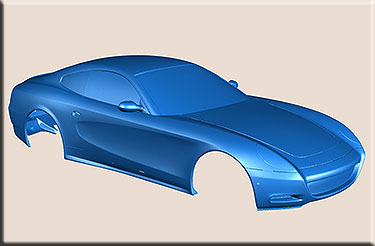

Rivoli January 2001. Result of the structured light optical scanning survey performed by Roberto Planesio of Vectorin.


Rivoli February 2001. C-class surfaces of the Ferrari F137.


Rivoli March 2001. Class A surfaces of the Ferrari F137.


Rivoli March 2001. Mathematical surfaces of class A Shading of the Ferrari F137.
 Rivoli early April 2001. Final rendering of the Ferrari F137.
Rivoli early April 2001. Final rendering of the Ferrari F137.



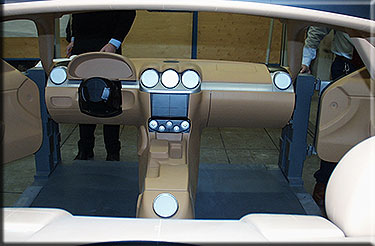


Rivoli - Modena spring 2001. Having received the style model of the interiors of the F 137 designed and built by Pininfarina, the optical surveys and mathematical surfaces in class A were carried out. The construction of the Master models of the interiors was contracted by Stola a.p.a. at Modelleria Modenese.
The use of this latest major investment would allow them to obtain high levels of quality in every detail, thanks to the visualization of the surfaces being worked on the 3x2m, 3-D rear projected screen .
The subsequent milling of the exterior master took place in Rivoli, while the interior master was contracted out to Modelleria Modenese.
In the spring of 2001, both masters were validated by the Pininfarina, Ferrari and Stola teams in Rivoli.
 Rivoli at STOLA s.p.a. spring 2001. The moment of validation of the Master Mathematical Verification of the exterior of the Ferrari F137 designed by Pininfarina which will later be called 612 Scaglietti. From left, Migliorini, Maurizio Rossi, Pighetti, Guidetti, Paolo Zerbini, Panzeri, Lorenzo Ramaciotti, Mauro Del Monte, Ottina, Carlo Mantovani.
Rivoli at STOLA s.p.a. spring 2001. The moment of validation of the Master Mathematical Verification of the exterior of the Ferrari F137 designed by Pininfarina which will later be called 612 Scaglietti. From left, Migliorini, Maurizio Rossi, Pighetti, Guidetti, Paolo Zerbini, Panzeri, Lorenzo Ramaciotti, Mauro Del Monte, Ottina, Carlo Mantovani.
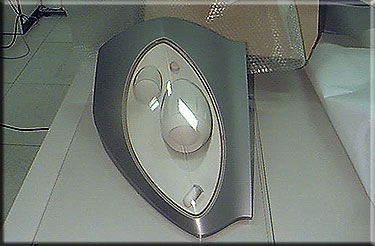 Rivoli 2001. Detail of the headlight of the Ferrari F137 CNC milled in Stola s.p.a. with class A mathematics.Thus began the phase of defining the bodywork studies, consisting of the floor, sides, greenhouse, closures and all the related internal structures in aluminium, as well as the plastic parts, bumpers , lights and the two sill covers.
Rivoli 2001. Detail of the headlight of the Ferrari F137 CNC milled in Stola s.p.a. with class A mathematics.Thus began the phase of defining the bodywork studies, consisting of the floor, sides, greenhouse, closures and all the related internal structures in aluminium, as well as the plastic parts, bumpers , lights and the two sill covers.
In parallel, the interior designers were responsible for defining the studies of the details of the instrument panel, console, door panels, pillars, headlining and boot linings.
The design team expanded to around 50 people.
Catia V4 was used for the development studies and 3D components.
The design phase described was very important as it defined the technological solutions capable of maintaining on the one hand the aesthetics required by styling and on the other the final costs of the car.
There was almost constant use of both the VR rooms at Rivoli and Cinisello Balsamo by the Stola team, allowing the Ferrari technicians to be even more pro-active in sharing design solutions. This was especially useful in very complex areas where there were many different components, such as the engine compartment. Stereoscopic 3D visualization using Catia Navigator software allowed specialists to analyze virtually the critical points of all systems.
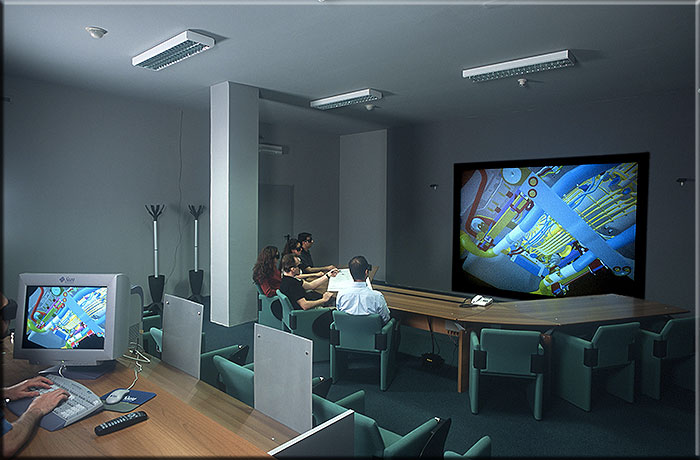 Cinisello Balsamo September 2001. A typical daily session of DMU (Digital Mock Up) in a virtual room to verify interference in the assembly of engine tubes, brakes and wiring.
Cinisello Balsamo September 2001. A typical daily session of DMU (Digital Mock Up) in a virtual room to verify interference in the assembly of engine tubes, brakes and wiring.
In Italy at the time, VR rooms equipped for car design were really rare, and the novelty that this new way of working allowed customers, their partner suppliers and the many co-designers to interact together, in real time in front of a large 3D screen animated by a computer.
 Cinisello Balsamo October 2002. Loredana Beltramino, Piero De Micheli, Carmelo Benedetto and XFerrari, Stola and the many co-designers could then make the production details work together on a single platform and achieve their objectives.
Cinisello Balsamo October 2002. Loredana Beltramino, Piero De Micheli, Carmelo Benedetto and XFerrari, Stola and the many co-designers could then make the production details work together on a single platform and achieve their objectives.
The validation of the 3D project took place firstly through checks using virtual electronic systems and subsequently on the first prototypes made in Maranello.
This highly critical activity for the F137 project, is entrusted to STOLA s.p.a. and largely carried out at Ferrari’s site.
 Maranello November 2002, at the Ferrari metrology room with the first prototype sheet metal body of the F137 later called Ferrari 612 Scaglietti. From left Alessandro Ghezzi, Paolo Zerbini and Piero De Micheli.
Maranello November 2002, at the Ferrari metrology room with the first prototype sheet metal body of the F137 later called Ferrari 612 Scaglietti. From left Alessandro Ghezzi, Paolo Zerbini and Piero De Micheli.
 Maranello November 2002, Toni Fabio, Piero De Micheli and Mauro Del Monte.
Maranello November 2002, Toni Fabio, Piero De Micheli and Mauro Del Monte. Maranello November 2002 Paolo Zerbini, Piero De Micheli and Mauro Del Monte.
Maranello November 2002 Paolo Zerbini, Piero De Micheli and Mauro Del Monte.
The Ferrari 612 Scaglietti was presented to the world on January 4, 2004 at the Detroit Auto Show.
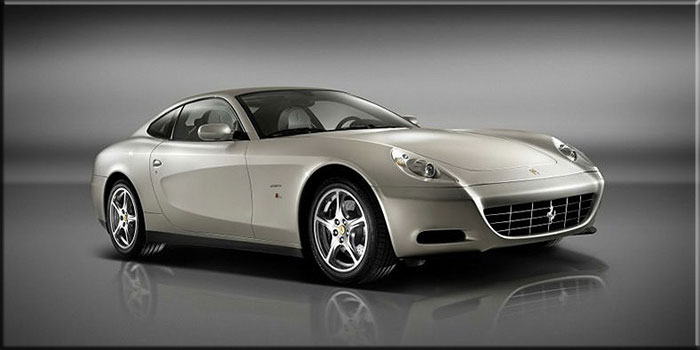 December 2003 The official photo of the Ferrari 612 Scaglietti designed by Pininfarina presented at the Detroit Auto Show on January 4, 2004.
December 2003 The official photo of the Ferrari 612 Scaglietti designed by Pininfarina presented at the Detroit Auto Show on January 4, 2004.
 December 2003. The official photo of the interior of the Ferrari 612 Scaglietti presented in Detroit on January 4th 2004.
December 2003. The official photo of the interior of the Ferrari 612 Scaglietti presented in Detroit on January 4th 2004.
On the 26th January, the Stola designers were invited by Cordero di Montezemolo to Maranello, together with the other partner suppliers in order to view the 612 Scaglietti, the occasion was the presentation of the F2004 single-seater in the presence of the drivers Michael Schumacher and Rubens Barrichello.
 Maranello 26 January 2004 on the occasion of the presentation of the new F2004 single-seater Alfredo Stola takes this incredible photograph.
Maranello 26 January 2004 on the occasion of the presentation of the new F2004 single-seater Alfredo Stola takes this incredible photograph.


Maranello 26 January 2004. Guests of Ferrari s.p.a. at the presentation of the new F2004 single-seater. From left Roberto Arpini, Piero De Micheli and engineer Carlo Alecci with Alfredo Stola.
 Maranello January 26, 2004. From left Mauro Del Monte, Piero De Micheli and Robero Arpini on the occasion of the presentation of the new F2004 single-seater pose near the Ferrari 612 Scaglietti presented a few days earlier at the Detroit Motor Show.
Maranello January 26, 2004. From left Mauro Del Monte, Piero De Micheli and Robero Arpini on the occasion of the presentation of the new F2004 single-seater pose near the Ferrari 612 Scaglietti presented a few days earlier at the Detroit Motor Show.



 October 2000 The drawings of Aldo Brovarone.
October 2000 The drawings of Aldo Brovarone.






 A. Stola, F. Secoli and G. Grande.
A. Stola, F. Secoli and G. Grande.  V. Mammone and Trosa
V. Mammone and Trosa A.Stola, F. Secoli, D. Secoli and Trosa.
A.Stola, F. Secoli, D. Secoli and Trosa.  Trosa and V. Mammone.
Trosa and V. Mammone. Trosa
Trosa





 March 2001, X, Maria Paola Stola, Roberto Stola and Fabrizio Giugiaro.
March 2001, X, Maria Paola Stola, Roberto Stola and Fabrizio Giugiaro.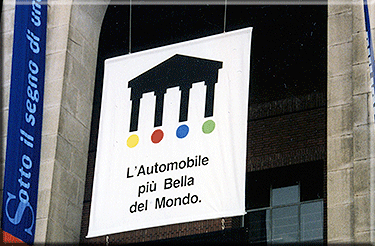
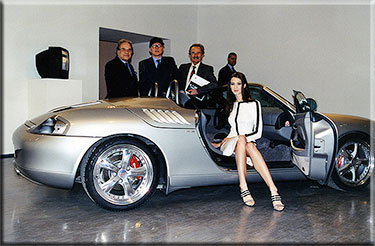
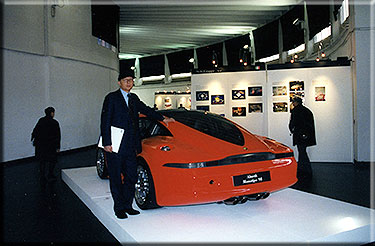
 Milan March 2001. Bruno Alfieri's desire is to also have the Abarth Monotipo Stola. Posing Alfredo and Eng. Alberto Sasso.
Milan March 2001. Bruno Alfieri's desire is to also have the Abarth Monotipo Stola. Posing Alfredo and Eng. Alberto Sasso. Milan March 2001. Inside the Triennale, Eng. Bruno Sacco, Alfredo Stola and Aldo Brovarone.
Milan March 2001. Inside the Triennale, Eng. Bruno Sacco, Alfredo Stola and Aldo Brovarone.
